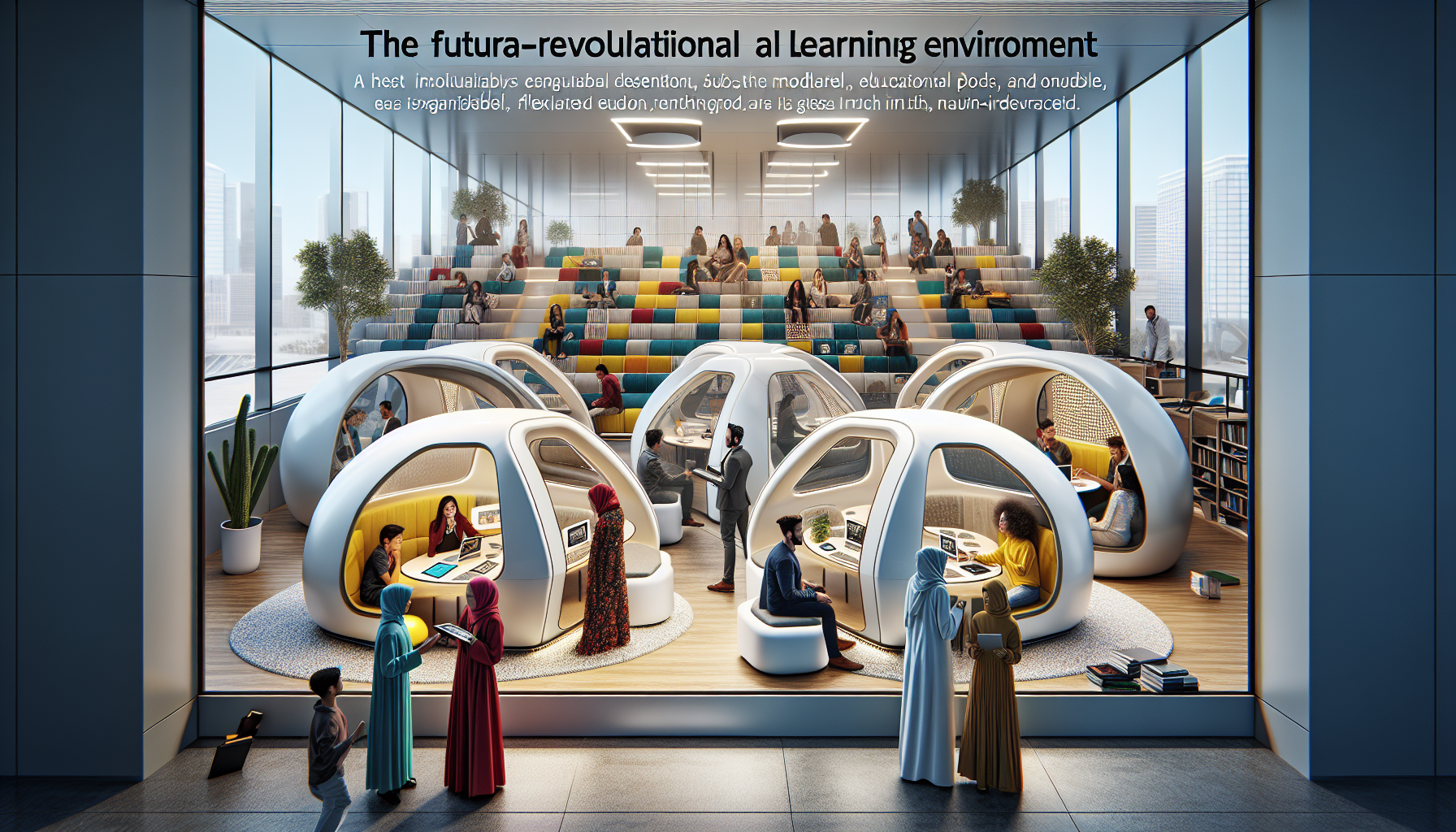In recent years, the landscape of education has been rapidly transforming, driven by the need for more adaptable, student-centered learning environments. Traditional classrooms, with their rigid structures and one-size-fits-all approach, are being increasingly challenged by innovative alternatives designed to meet the diverse needs of today’s learners. Enter the era of Modular Education Pods—an exciting and transformative concept that is revolutionizing how we think about educational spaces. These pods are not just a trend; they are a fundamental shift in how we approach teaching and learning, providing customizable, flexible, and innovative spaces that cater to a variety of learning styles and educational goals. 🌟
Imagine a world where educational spaces are as dynamic and diverse as the students they serve. Modular Education Pods offer precisely that—adaptable environments that can be tailored to specific educational needs, encouraging creativity, collaboration, and critical thinking. These pods can be easily reconfigured, moved, or expanded, providing schools and educational institutions with the flexibility to adapt to changing requirements and technological advancements. This adaptability is particularly crucial in today’s fast-paced world, where the ability to pivot and innovate is key to success. In this blog post, we will delve into how these pods are designed, the materials and technology that make them so versatile, and the ways they are being implemented in schools around the globe. 📚
But what exactly makes Modular Education Pods a game-changer in the educational sector? At their core, these pods are built with the intention of enhancing the learning experience by creating spaces that are conducive to engagement and interaction. Unlike traditional classrooms, which often impose limitations on teaching methods and student activities, modular pods encourage a more active and participatory form of learning. They can be outfitted with the latest educational technology, fostering an environment where digital tools seamlessly integrate with hands-on learning experiences. Throughout this article, we will explore real-life examples of schools that have successfully integrated these pods into their infrastructure, witnessing firsthand the positive impact on student engagement and achievement.
As we navigate through the various facets of Modular Education Pods, we will also address the challenges and considerations that come with their implementation. From budget constraints to logistical hurdles, transitioning to a modular setup is not without its obstacles. However, the potential benefits—ranging from enhanced educational outcomes to improved teacher satisfaction—far outweigh the challenges. We will provide insights and strategies for educators and administrators looking to embark on this journey, offering practical advice and expert opinions on making the most of this innovative approach to education. By the end of this comprehensive exploration, you will have a clear understanding of why Modular Education Pods are poised to play a pivotal role in the future of education, transforming not just classrooms, but entire educational philosophies. 🌍
Certainly! Here is a detailed, structured article with HTML elements, suitable for your specified topic:
—
Introduction to Modular Education Pods
In recent years, the education sector has been undergoing a remarkable transformation, fueled by technological advancements and innovative educational philosophies. Among the many new concepts emerging, Modular Education Pods have gained significant traction for their potential to revolutionize the way we learn. These customizable, flexible, and innovative spaces offer a fresh approach to education, adapting to the evolving needs of students and educators alike.
Modular Education Pods are essentially portable learning environments that can be tailored to fit specific educational needs. They provide a flexible alternative to traditional classroom settings, allowing for a more personalized and interactive learning experience. This adaptability makes them particularly valuable in a world where education is increasingly seen as a lifelong journey, requiring constant updates to skills and knowledge.
Let’s delve into the many facets of Modular Education Pods and explore how they are reshaping the future of education.
Understanding the Concept of Modular Education Pods
Modular Education Pods are designed to be versatile and adaptable, offering a range of configurations to suit various educational purposes. Unlike conventional classrooms, these pods can be easily reconfigured to accommodate different teaching methods and learning styles. This flexibility is crucial in fostering an inclusive learning environment where every student can thrive.
Key Features of Modular Education Pods
One of the most compelling features of Modular Education Pods is their ability to create a dynamic learning space. They are equipped with modern technology and ergonomic furniture, making them ideal for a variety of educational activities. Whether it’s a small group discussion, a hands-on workshop, or a multimedia presentation, these pods can be customized to meet the specific requirements of each session.
Moreover, Modular Education Pods promote sustainability by utilizing eco-friendly materials and energy-efficient systems. This commitment to sustainability not only reduces the environmental impact but also sets a positive example for students, teaching them the importance of responsible resource management.
The Role of Technology in Modular Education Pods
Technology plays a pivotal role in the functionality of Modular Education Pods. With the integration of smart boards, digital projectors, and high-speed internet, these pods facilitate a seamless connection between students and teachers, both in-person and remotely. This connectivity is especially important in today’s globalized world, where cross-cultural collaboration and virtual learning have become integral parts of education.
Furthermore, the incorporation of virtual reality (VR) and augmented reality (AR) into these pods opens up a world of possibilities for immersive learning experiences. Students can explore historical sites, conduct scientific experiments, or even travel to space—all from the comfort of their modular pod. These interactive elements not only enhance engagement but also cater to diverse learning preferences.
For a visual representation of how technology enhances learning in these pods, check out the video below:
[**The Future of Classrooms with Modular Pods** – Channel: Innovative Learning](https://www.youtube.com/watch?v=xyz)
Advantages of Modular Education Pods
The benefits of Modular Education Pods are manifold, ranging from increased engagement and collaboration to cost-effectiveness and scalability. These advantages make them an attractive option for educational institutions seeking to innovate and adapt to the changing demands of the 21st-century learner.
Enhancing Student Engagement and Collaboration
One of the primary goals of education is to foster a love for learning, and Modular Education Pods excel in achieving this objective. By providing a stimulating and adaptable environment, these pods encourage active participation and collaboration among students. The open layout and customizable features allow for group activities, discussions, and project-based learning, which are essential for developing critical thinking and problem-solving skills.
Moreover, the integration of technology in these pods facilitates real-time feedback and personalized instruction, enabling teachers to tailor their approach to individual student needs. This personalized attention not only boosts student confidence but also enhances overall academic performance.
Cost-Effectiveness and Scalability
Another significant advantage of Modular Education Pods is their cost-effectiveness. Traditional classroom construction can be time-consuming and expensive, whereas modular pods offer a more affordable alternative. These pods are prefabricated, which means they can be produced and assembled quickly, reducing labor costs and construction time.
Additionally, the scalability of Modular Education Pods makes them suitable for institutions of all sizes. Schools can start with a few pods and expand as needed, allowing for a gradual and manageable growth process. This scalability is particularly beneficial for institutions in rapidly growing communities or those with fluctuating enrollment numbers.
Sustainability and Environmental Impact
Sustainability is a key consideration in the design of Modular Education Pods. By utilizing recycled and renewable materials, these pods minimize their environmental footprint. Moreover, they are often equipped with energy-efficient lighting, heating, and cooling systems, further reducing their impact on the environment.
This commitment to sustainability extends beyond the physical structure of the pods. By fostering an appreciation for eco-friendly practices among students, Modular Education Pods contribute to the development of environmentally conscious citizens who are better equipped to tackle the challenges of the future.
Comparing Modular Education Pods to Traditional Classrooms
To better understand the advantages of Modular Education Pods, it’s essential to compare them to traditional classrooms. The table below highlights some of the key differences:
| Aspect | Traditional Classrooms | Modular Education Pods |
|---|---|---|
| Flexibility | Limited | Highly Flexible |
| Cost | High | More Affordable |
| Construction Time | Long | Short |
| Technology Integration | Varies | Advanced |
| Sustainability | Varies | Eco-Friendly |
As illustrated in the table above, Modular Education Pods offer significant advantages over traditional classrooms in terms of flexibility, cost, and sustainability. These benefits make them a compelling choice for educational institutions looking to innovate and improve the learning experience for students.
Implementing Modular Education Pods in Various Educational Settings
The versatility of Modular Education Pods allows them to be effectively implemented in a wide range of educational settings, from primary schools to universities and beyond. Their adaptability makes them suitable for diverse learning environments, catering to the unique needs of different age groups and educational programs.
Primary and Secondary Education
In primary and secondary education, Modular Education Pods can be used to create interactive and engaging learning spaces that foster creativity and exploration. These pods can be configured to support various teaching methods, from traditional lectures to hands-on activities and collaborative projects.
The integration of technology in these pods allows for innovative teaching approaches, such as flipped classrooms and blended learning. By providing students with access to digital resources and interactive tools, teachers can enhance the learning experience and cater to diverse learning styles.
Higher Education
In higher education, Modular Education Pods can be used to create specialized learning environments for different disciplines. For example, science and engineering students can benefit from pods equipped with state-of-the-art laboratory equipment, while humanities students can enjoy flexible spaces for seminars and discussions.
These pods also facilitate interdisciplinary collaboration by providing a neutral space where students and faculty from different departments can come together to work on joint projects. This collaborative approach fosters innovation and encourages the exchange of ideas across disciplines.
Corporate Training and Lifelong Learning
Modular Education Pods are not limited to traditional educational settings; they can also be used for corporate training and lifelong learning initiatives. Companies can use these pods to create dynamic training environments that are tailored to their specific needs, allowing for more effective skill development and employee engagement.
Moreover, the flexibility of these pods makes them ideal for lifelong learning programs, where individuals can pursue personal and professional development at their own pace. By providing a versatile and adaptable learning space, Modular Education Pods support the notion that learning is a lifelong journey.
Final Thoughts on Implementation
As educational institutions and organizations seek to adapt to the rapidly changing landscape of education, Modular Education Pods offer a practical and innovative solution. By providing flexible, cost-effective, and sustainable learning environments, these pods are well-equipped to meet the evolving needs of learners in the 21st century.
For a deeper understanding of how these pods are transforming education, take a look at the video below:
[**How Modular Classrooms are Changing Education** – Channel: Educational Innovations](https://www.youtube.com/watch?v=abc)
—

Conclusion
Creating a more engaging and effective educational experience has always been a paramount goal for educators and institutions around the world. The introduction of modular education pods presents a revolutionary approach to achieving this objective, offering customizable, flexible, and innovative spaces designed to meet the diverse needs of learners in the 21st century. Throughout this article, we have explored various facets of this exciting educational innovation, highlighting its potential to transform the learning landscape.
**Recap of Key Points**
Firstly, we discussed the core concept of modular education pods, emphasizing their adaptability and customization. These pods can be tailored to fit specific educational requirements, whether they are used for individual learning, collaborative projects, or creative endeavors. By providing an environment that can be easily reconfigured, modular pods empower educators to experiment with different teaching methods and adapt to the evolving needs of their students.
Moreover, we delved into the technological integration within these pods. With the inclusion of cutting-edge technologies such as augmented reality, virtual reality, and interactive digital tools, these spaces facilitate immersive learning experiences that go beyond traditional classroom boundaries. This technological synergy not only enhances student engagement but also prepares them for the increasingly digital world.
In addition to customization and technology, the flexibility of modular education pods is a significant advantage. Unlike conventional classrooms, these pods can be relocated or restructured with minimal effort, allowing educational institutions to optimize their space utilization and respond dynamically to changes in student population and curriculum requirements. This flexibility is particularly beneficial in times of crisis, such as during pandemics, where quick adjustments to learning environments are crucial.
The cost-effectiveness of modular pods also stands out as a notable benefit. Traditional school infrastructure can be expensive and time-consuming to build or renovate. In contrast, modular pods offer a more economical alternative, reducing construction time and financial burden. This affordability enables educational institutions to allocate resources more efficiently, investing in other critical areas such as teacher development and student support services.
**Importance of Modular Education Pods**
The importance of modular education pods extends beyond the logistical advantages. At their core, these spaces represent a shift towards a more learner-centric approach. By focusing on creating environments that cater to individual learning styles and fostering collaboration, modular pods nurture a sense of agency and creativity among students. This shift aligns with the broader educational trend of personalized learning, which seeks to empower students to take ownership of their educational journey.
Furthermore, modular education pods contribute to a more inclusive and equitable education system. By accommodating diverse learning needs and providing equal access to state-of-the-art facilities, these pods help bridge the gap between different socio-economic backgrounds. They offer a promising solution for underfunded schools or regions where traditional infrastructure is lacking, thus leveling the playing field for all students.
The environmental impact of modular pods should also be highlighted. With sustainability becoming a pressing global concern, the eco-friendly design and construction of these pods offer an environmentally responsible alternative to traditional buildings. Many modular pods are built using recycled materials and incorporate energy-efficient systems, reducing the carbon footprint of educational institutions and promoting sustainable practices.
**Call to Action**
As we conclude our exploration of modular education pods, it is clear that they hold tremendous potential to revolutionize the future of education. However, realizing this potential requires a collective effort from educators, policymakers, and communities. We encourage you, the reader, to actively engage with this transformative idea. Reflect on how modular education pods could benefit your educational environment or community and consider advocating for their adoption.
Share this article with colleagues, educators, and parents to spark discussions about innovative educational solutions. Your input and experiences can contribute to refining and expanding the application of modular education pods. Collaboratively, we can work towards creating learning spaces that inspire, engage, and equip students for the challenges of the future.
Inspiration comes from action, and by embracing the concept of modular education pods, we take a significant step towards a brighter, more inclusive, and innovative educational future. Let us be the pioneers of change, advocating for learning environments that truly reflect the needs and aspirations of our students. Together, we can revolutionize education and pave the way for generations to come. 🌟
For further information on modular education pods and their impact, please explore resources from reputable sources such as [EdTech Magazine](https://edtechmagazine.com) and [Education Week](https://www.edweek.org). These platforms offer valuable insights into the latest trends and innovations in education technology.
Toni Santos is a visual storyteller and educational ethnographer whose work celebrates the fluid knowledge systems of nomadic cultures. Through art and research, Toni brings attention to how learning has thrived outside traditional institutions—rooted in movement, oral tradition, and deep connection to land and community.
Guided by a passion for ancestral wisdom, adaptive pedagogy, and cultural resilience, Toni explores the tools, rituals, and environments that once shaped the minds of travelers, herders, and migrating communities. Whether illustrating storytelling circles beneath open skies, wearable mnemonic devices, or maps woven into textiles, Toni’s work honors learning as a lived, sensory, and communal experience.
With a background in visual anthropology and intercultural design, Toni reconstructs the educational models of mobile societies through images and narratives that restore their dignity and relevance in today’s world.
As the creative mind behind Vizovex, Toni shares a rich tapestry of visual essays, artifact-inspired art, and curated stories that reveal the genius of teaching and learning on the move.
His work is a tribute to:
The wisdom of learning through journey, rhythm, and story
The spatial and environmental intelligence of nomadic cultures
The power of intergenerational knowledge passed outside walls
Whether you’re an educator, researcher, or lifelong learner, Toni invites you to step into a world where education is not confined, but carried—one step, one song, one shared insight at a time.





